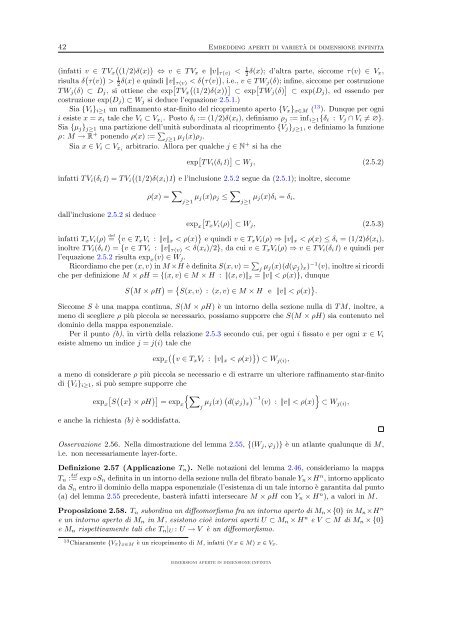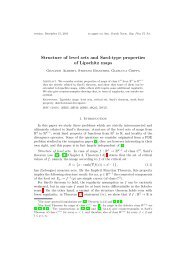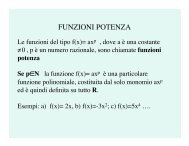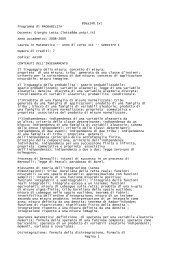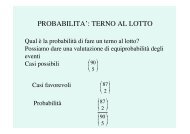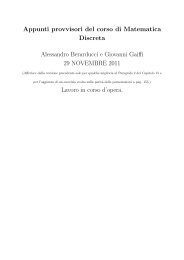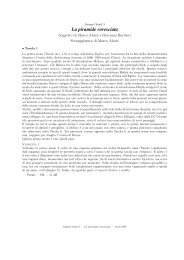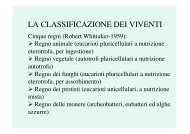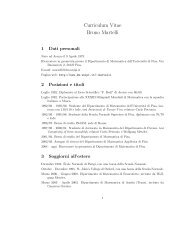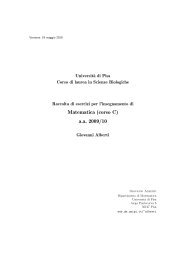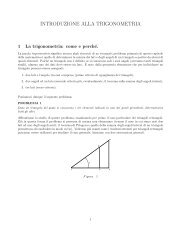Immersioni aperte in dimensione infinita - Dipartimento di Matematica
Immersioni aperte in dimensione infinita - Dipartimento di Matematica
Immersioni aperte in dimensione infinita - Dipartimento di Matematica
You also want an ePaper? Increase the reach of your titles
YUMPU automatically turns print PDFs into web optimized ePapers that Google loves.
42 Embedd<strong>in</strong>g aperti <strong>di</strong> varietà <strong>di</strong> <strong><strong>di</strong>mensione</strong> <strong>in</strong>f<strong>in</strong>ita<br />
<br />
(<strong>in</strong>fatti v ∈ T Vx (1/2)δ(x) ⇔ v ∈ T Vx e |v | τ(v) < 1<br />
2δ(x); d’altra parte, siccome τ(v) ∈ Vx,<br />
risulta δ τ(v) > 1<br />
2δ(x) e qu<strong>in</strong><strong>di</strong> |v | τ(v) < δ τ(v) , i.e., v ∈ T Wj(δ); <strong>in</strong>f<strong>in</strong>e, siccome per costruzione<br />
T Wj(δ) ⊂ Dj, si ottiene che exp <br />
T Vx (1/2)δ(x) ⊂ exp T Wj(δ) ⊂ exp(Dj), ed essendo per<br />
costruzione exp(Dj) ⊂ Wj si deduce l’equazione 2.5.1.)<br />
Sia {Vi}i≥1 un raff<strong>in</strong>amento star-f<strong>in</strong>ito del ricoprimento aperto {Vx}x∈M ( 13 ). Dunque per ogni<br />
i esiste x = xi tale che Vi ⊂ Vxi . Posto δi := (1/2)δ(xi), def<strong>in</strong>iamo ρj := <strong>in</strong>fi≥1{δi : Vj ∩ Vi = ∅}.<br />
Sia {µj}j≥1 una partizione dell’unità subord<strong>in</strong>ata al ricoprimento {Vj}j≥1, e def<strong>in</strong>iamo la funzione<br />
ρ: M → R + ponendo ρ(x) := <br />
j≥1 µj(x)ρj.<br />
Sia x ∈ Vi ⊂ Vxi arbitrario. Allora per qualche j ∈ N + si ha che<br />
exp T Vi(δi1) ⊂ Wj, (2.5.2)<br />
<br />
<strong>in</strong>fatti T Vi(δi1) = T Vi (1/2)δ(xi)1 e l’<strong>in</strong>clusione 2.5.2 segue da (2.5.1); <strong>in</strong>oltre, siccome<br />
ρ(x) = <br />
j≥1 µj(x)ρj ≤ <br />
j≥1 µj(x)δi = δi,<br />
dall’<strong>in</strong>clusione 2.5.2 si deduce<br />
<br />
expx TxVi(ρ) ⊂ Wj, (2.5.3)<br />
<strong>in</strong>fatti TxVi(ρ) def<br />
= v ∈ TxVi : |v |x < ρ(x) e qu<strong>in</strong><strong>di</strong> v ∈ TxVi(ρ) ⇒ |v |x < ρ(x) ≤ δi = (1/2)δ(xi),<br />
<strong>in</strong>oltre T Vi(δi1) = {v ∈ T Vi : |v | τ(v) < δ(xi)/2}, da cui v ∈ TxVi(ρ) ⇒ v ∈ T Vi(δi1) e qu<strong>in</strong><strong>di</strong> per<br />
l’equazione 2.5.2 risulta expx(v) ∈ Wj.<br />
Ricor<strong>di</strong>amo che per (x, v) <strong>in</strong> M ×H è def<strong>in</strong>ita S(x, v) = <br />
j µj(x)(d(ϕj)x) −1 (v), <strong>in</strong>oltre si ricor<strong>di</strong><br />
che per def<strong>in</strong>izione M × ρH = {(x, v) ∈ M × H : |(x, v)|x = |v | < ρ(x)}, dunque<br />
S M × ρH = S(x, v) : (x, v) ∈ M × H e |v | < ρ(x) .<br />
Siccome S è una mappa cont<strong>in</strong>ua, S(M × ρH) è un <strong>in</strong>torno della sezione nulla <strong>di</strong> T M, <strong>in</strong>oltre, a<br />
meno <strong>di</strong> scegliere ρ più piccola se necessario, possiamo supporre che S(M × ρH) sia contenuto nel<br />
dom<strong>in</strong>io della mappa esponenziale.<br />
Per il punto (b), <strong>in</strong> virtù della relazione 2.5.3 secondo cui, per ogni i fissato e per ogni x ∈ Vi<br />
esiste almeno un <strong>in</strong><strong>di</strong>ce j = j(i) tale che<br />
<br />
expx v ∈ TxVi : |v |x < ρ(x) ⊂ Wj(i), a meno <strong>di</strong> considerare ρ più piccola se necessario e <strong>di</strong> estrarre un ulteriore raff<strong>in</strong>amento star-f<strong>in</strong>ito<br />
<strong>di</strong> {Vi}i≥1, si può sempre supporre che<br />
<br />
expx S {x} × ρH = expx<br />
j µj(x) <br />
−1(v)<br />
d(ϕj)x : |v | < ρ(x) ⊂ Wj(i), e anche la richiesta (b) è sod<strong>di</strong>sfatta.<br />
Osservazione 2.56. Nella <strong>di</strong>mostrazione del lemma 2.55, {(Wj, ϕj)} è un atlante qualunque <strong>di</strong> M,<br />
i.e. non necessariamente layer-forte.<br />
Def<strong>in</strong>izione 2.57 (Applicazione Tn). Nelle notazioni del lemma 2.46, consideriamo la mappa<br />
Tn : def<br />
= exp ◦Sn def<strong>in</strong>ita <strong>in</strong> un <strong>in</strong>torno della sezione nulla del fibrato banale Yn×H n , <strong>in</strong>torno applicato<br />
da Sn entro il dom<strong>in</strong>io della mappa esponenziale (l’esistenza <strong>di</strong> un tale <strong>in</strong>torno è garantita dal punto<br />
(a) del lemma 2.55 precedente, basterà <strong>in</strong>fatti <strong>in</strong>tersecare M × ρH con Yn × H n ), a valori <strong>in</strong> M.<br />
Proposizione 2.58. Tn subord<strong>in</strong>a un <strong>di</strong>ffeomorfismo fra un <strong>in</strong>torno aperto <strong>di</strong> Mn×{0} <strong>in</strong> Mn×H n<br />
e un <strong>in</strong>torno aperto <strong>di</strong> Mn <strong>in</strong> M, esistono cioè <strong>in</strong>torni aperti U ⊂ Mn × H n e V ⊂ M <strong>di</strong> Mn × {0}<br />
e Mn rispettivamente tali che Tn|U : U → V è un <strong>di</strong>ffeomorfismo.<br />
13 Chiaramente {Vx}x∈M è un ricoprimento <strong>di</strong> M, <strong>in</strong>fatti (∀ x ∈ M) x ∈ Vx.<br />
IMMERSIONI APERTE IN DIMENSIONE INFINITA


